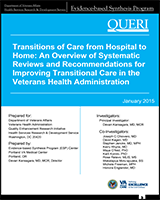NCBI Bookshelf. A service of the National Library of Medicine, National Institutes of Health.
Kansagara D, Chiovaro JC, Kagen D, et al. Transitions of Care from Hospital to Home: An Overview of Systematic Reviews and Recommendations for Improving Transitional Care in the Veterans Health Administration [Internet]. Washington (DC): Department of Veterans Affairs (US); 2015 Jan.

Transitions of Care from Hospital to Home: An Overview of Systematic Reviews and Recommendations for Improving Transitional Care in the Veterans Health Administration [Internet].
Show details| Key Questions | KQ1. What are the overlapping elements identified in existing systematic reviews that promote successful hospital-to-home transitions? We propose a review of systematic reviews to identify the common themes that have emerged from reviews that have focused on specific patient populations (eg, MI, pneumonia, COPD, and CHF). We will then identify randomized controlled trials that include diverse patient populations and test the effects of transitional care interventions on readmission rates (KQ2). | KQ2. How do intervention, population, and health care setting characteristics modify the effectiveness of transitional care interventions in lowering readmissions and/or reducing mortality?
| ||
|---|---|---|---|---|
| Population | Include: Adults discharged from the hospital
| |||
| Intervention | We will define interventions as those that include “a set of actions designed to ensure the coordination and continuity of health care as patients transfer between different locations or different levels of care” (Coleman 2004) and/or help prepare patients/caregivers to self-manage their care after discharge from a hospital. Interventions can take place before or after discharge, or include components that span settings (aka bridging interventions). Key processes of interventions may include patient education, motivational interviewing, medication reconciliation, risk-based dosing, monitoring/remote data collection, personal health record, single point of contact, outpatient/provider follow-up, advanced care planning, and care coordination. Characteristics of the intervention, such as facilitator, recipient, intensity (frequency and duration), method of contact, and other aspects, may vary, and will be abstracted and analyzed as covariates. | |||
| Comparator | Usual care, or other included intervention (ie, head-to-head trial) | |||
| Outcomes of interest | Primary outcomes of interest: readmission rate, mortality Secondary outcomes:
| Readmission rate Mortality | ||
| Timing | Any timeframe | |||
| Included study designs | Systematic reviews, meta-analyses, meta-regression studies | Controlled clinical trials | ||
| Excluded study designs | Observational studies, case series, case reports | |||
| Setting |
| |||
| System Type | European | Asian | ||
| UK NHS Model | UK, Spain, Italy, Norway, Finland, Sweden, | Hong Kong, New Zealand, | ||
| Bismarck Model | Germany, France, Belgium, the Netherlands, Switzerland | Japan | ||
| National Health Insurance Model | Canada | Taiwan, South Korea, Australia | ||
| ||||
- INCLUSION/EXCLUSION CRITERIA - Transitions of Care from Hospital to Home: An Ove...INCLUSION/EXCLUSION CRITERIA - Transitions of Care from Hospital to Home: An Overview of Systematic Reviews and Recommendations for Improving Transitional Care in the Veterans Health Administration
- FXYD domain-containing ion transport regulator 5 isoform 1 precursor [Homo sapie...FXYD domain-containing ion transport regulator 5 isoform 1 precursor [Homo sapiens]gi|47778938|ref|NP_659003.1|Protein
- tubulin-specific chaperone D isoform 1 [Homo sapiens]tubulin-specific chaperone D isoform 1 [Homo sapiens]gi|41350333|ref|NP_005984.3|Protein
Your browsing activity is empty.
Activity recording is turned off.
See more...